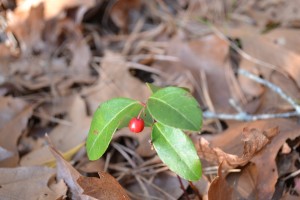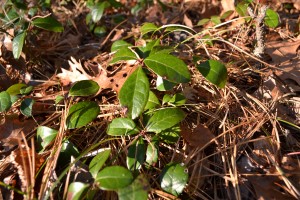 While walking by a stand of wintergreen (Gaultheria procumbens), I mentioned to my friend that the plant was edible, or at least chewable. He put this to the test immediately and ate one of the berries, proclaiming that it did have an oily wintergreeny taste, albeit subtle. I almost suggested a non-descript looking mushroom to him, but thought better of that. Since the original goal of walking by – a fishing trip – got curtailed by the cold and the lack of bite under the surface, I figured I’d spend some time delving into the background and uses of this plant.
While walking by a stand of wintergreen (Gaultheria procumbens), I mentioned to my friend that the plant was edible, or at least chewable. He put this to the test immediately and ate one of the berries, proclaiming that it did have an oily wintergreeny taste, albeit subtle. I almost suggested a non-descript looking mushroom to him, but thought better of that. Since the original goal of walking by – a fishing trip – got curtailed by the cold and the lack of bite under the surface, I figured I’d spend some time delving into the background and uses of this plant.
Wintergreen is known under many different monikers – checkerberry, teaberry, mountain tea, ivy-leaves, etc. It likes infertile forests under evergreens. This habitat is wide-spread on the Cape. If you don’t have pine trees nearby, you can “augment” the already sandy and acidic soil by adding a couple of inches of pine needles. You should be able to transpant the wintergreen into this fairly easily. Keep in mind that you are not dealing with individual plants, but with a creeping bush. Make sure to get enough of the plant to have it be viable. The stems and roots run along the surface or just below it.
The plant has leaves all year, but berries are to be found fall through spring only. The evergreen leaves are shiny and accumulate at the end of short, 3-6 inch, branches. Younger leaves are fleshy and are a pale yellowish green with some red, or in some cases they are all red. These leaves smell strongest of wintergreen when crushed. Older leaves are shiny and a darker green and tend to be less fragrant. Wintergreen blooms in the summer with little bell-shaped white flowers.

As for practical uses, Alan Hall’s wild food trail guide proves to be a good reference:
1. Wintergreen tea, made by steeping leaves in boiling water. Fresh leaves are best – the dried leaves lose a lot of the oil that gives it the wintergreen flavor.
2. The berries can be used for tea as well – they can be fermented in water which then can be heated for drinking.
3. The berries can be eaten as a snack, or added to pancakes or muffins. It is good to remember that the berries are better frozen – this makes them juicier and more plump.
Of course, both young leaves and berries are a refreshing treat when eaten raw. And that is not all – both leaves and berries contain a compound similar to aspirin that reduces fever, and minor aches and pains.
Leave a Reply